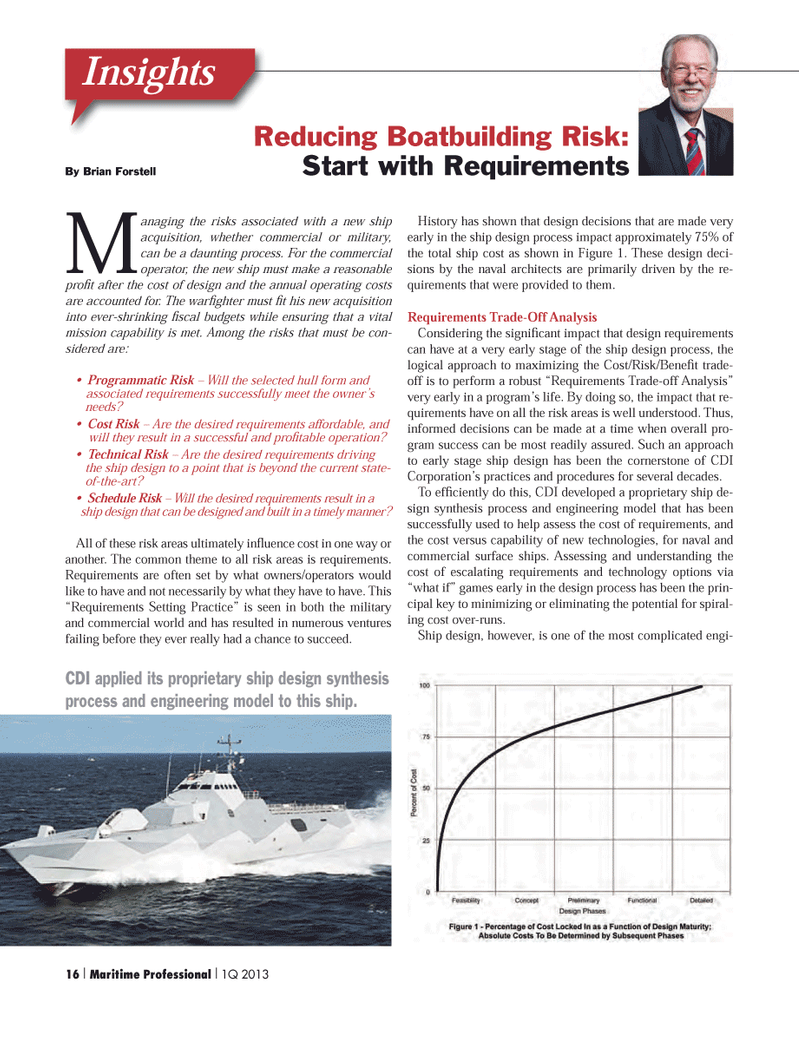
Page 16: of Maritime Logistics Professional Magazine (Q1 2013)
Maritime Risk
Read this page in Pdf, Flash or Html5 edition of Q1 2013 Maritime Logistics Professional Magazine
Managing the risks associated with a new ship acquisition, whether commercial or military, can be a daunting process. For the commercial operator, the new ship must make a reasonable proÞ t after the cost of design and the annual operating costs are accounted for. The warÞ ghter must Þ t his new acquisition into ever-shrinking Þ scal budgets while ensuring that a vital mission capability is met. Among the risks that must be con- sidered are: Programmatic Risk Ð Will the selected hull form and associated requirements successfully meet the ownerÕs needs? Cost Risk Ð Are the desired requirements affordable, and will they result in a successful and proÞ table operation? Technical Risk Ð Are the desired requirements driving the ship design to a point that is beyond the current state- of-the-art? Schedule Risk Ð Will the desired requirements result in a ship design that can be designed and built in a timely manner? All of these risk areas ultimately inß uence cost in one way or another. The common theme to all risk areas is requirements. Requirements are often set by what owners/operators would like to have and not necessarily by what they have to have. This ÒRequirements Setting PracticeÓ is seen in both the military and commercial world and has resulted in numerous ventures failing before they ever really had a chance to succeed. History has shown that design decisions that are made very early in the ship design process impact approximately 75% of the total ship cost as shown in Figure 1. These design deci- sions by the naval architects are primarily driven by the re- quirements that were provided to them. Requirements Trade-Off Analysis Considering the signiÞ cant impact that design requirements can have at a very early stage of the ship design process, the logical approach to maximizing the Cost/Risk/BeneÞ t trade- off is to perform a robust ÒRequirements Trade-off AnalysisÓ very early in a programÕs life. By doing so, the impact that re- quirements have on all the risk areas is well understood. Thus, informed decisions can be made at a time when overall pro- gram success can be most readily assured. Such an approach to early stage ship design has been the cornerstone of CDI CorporationÕs practices and procedures for several decades. To efÞ ciently do this, CDI developed a proprietary ship de- sign synthesis process and engineering model that has been successfully used to help assess the cost of requirements, and the cost versus capability of new technologies, for naval and commercial surface ships. Assessing and understanding the cost of escalating requirements and technology options via Òwhat ifÓ games early in the design process has been the prin-cipal key to minimizing or eliminating the potential for spiral- ing cost over-runs. Ship design, however, is one of the most complicated engi- Reducing Boatbuilding Risk:Start with Requirements By Brian ForstellRInsightsCDI applied its proprietary ship design synthesis process and engineering model to this ship. 16 I Maritime Professional I 1Q 2013MP #1 1-17.indd 16MP #1 1-17.indd 162/22/2013 10:35:45 AM2/22/2013 10:35:45 AM

 15
15

 17
17
